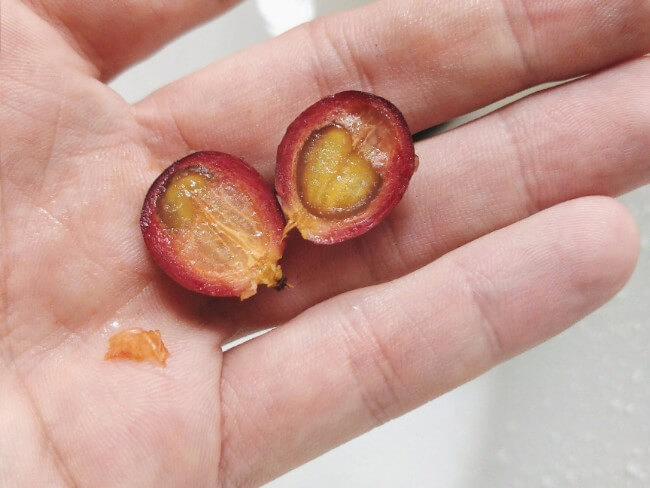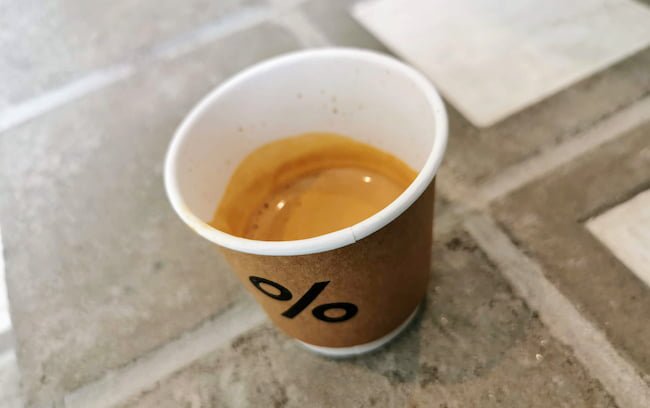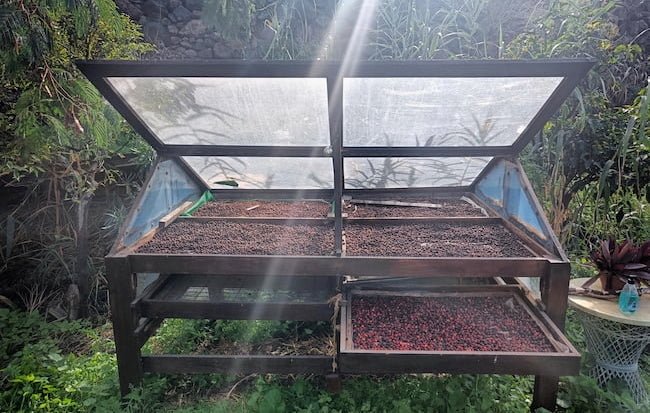Most people think of coffee as a strong, bitter drink that needs milk and sugar to be enjoyable.
But it doesn’t have to be that way 🙅
As we all know, a ripe banana or strawberry tastes sweeter than its unripe counterpart.
This principle also holds true for other fruits. And since coffee is a fruit, the rule applies here, too.
But getting the sweetest coffee possible requires more than just getting ripe beans. The key to unlocking the natural sweetness in coffee also lies in things such as roasting and brewing.
In this post, I’ll explore the science behind sweetness so that you can find that perfect cup of naturally sweet coffee.
Sweet coffee begins at the farm
Looking for sweet coffee? Then we gotta go back to the very start: the coffee cherry on the farm.
You might’ve noticed that the specialty coffee you find at hip cafes often tastes sweeter than your average supermarket coffee. That’s because the coffee beans, which come from the cherry of the coffee plant, are handpicked precisely when they’re perfectly ripe. They wait for the cherry to change from green to dark red, signaling that it’s at its sweetest.
Selective picking is essential because all the cherries on a coffee plant don’t ripen simultaneously.
You can actually measure the sweetness scientifically with something called “Brix readings”. This device measure the sweetness in coffee cherries by analysing sugar content in the juice. A higher Brix reading means a sweeter and riper cherry.
Commercial coffee beans, on the other hand, is often harvested mechanically, which means that both ripe and unripe cherries end up in your bag of cheap supermarket coffee. Or underpaid workers who aren’t incentivized to do selective picking are employed.
As you can guess, this approach leads to coffee that’s overall less sweet.

Sweetness without calories?
I should add that coffee can be sweet while containing no calories. This is pretty magical when you think about it.
Thanks to the natural flavors in coffee, and the way our taste buds work, coffee can taste sweet, even without sugar,
Coffee contains hundreds of compounds, some of which have a naturally sweet or fruity taste. For example, lighter roasts often have a fruity or wine-like acidity that can be perceived as sweet. On the other hand, medium roasts may have notes of chocolate or caramel, which can also be perceived as a type of sweetness.
How we taste things isn’t just about sweet, sour, salty, bitter, and umami (savory). It’s about how these tastes balance each other out. So if a coffee is a bit bitter but also acidic and fruity, it can taste sweet. Also, if it smells like something sweet, like chocolate or caramel, your brain might tell you it’s sweet.
Processing Methods – Unlocking the Sweetness
Different processing methods can significantly impact the perceived sweetness of the coffee. Natural and honey processes are known to enhance the coffee’s natural sugars and sweetness during fermentation:
- Natural Process: The coffee cherries are dried with their skin still on. This lets the beans soak up more of the cherry’s natural sugars, leading to a sweeter coffee with a thick body and fruity flavors. The downside is that you’ll sometimes get some slightly fermented flavors, but many people don’t mind this and just appreciate the boost in sweetness.
- Honey Process: The cherry’s skin and some pulp are removed, leaving a sticky, honey-like layer on the beans. This layer, also known as mucilage, contains the cherry’s natural sugars, which the beans absorb as they dry. Honey-processed coffees often have fruity notes with a noticeable sweetness.
Compared to these, the washed process (where the cherry is completely removed before drying) gives the coffee a cleaner, brighter taste, but it’s usually not as sweet. So if you’re after the sweetest coffee, go for beans that have been processed using the natural or honey methods.

Bean Types – Arabica vs. Robusta vs. Liberica
The type of coffee bean also plays a role in the level of natural sweetness:
- Arabica: These beans are known for their higher sugar content and sweeter taste than Robusta beans. They are the most common type of bean used in specialty coffee and are often associated with notes of chocolate, caramel, and fruit.
- Robusta: Containing less sugar than Arabica, Robusta beans are typically more bitter and less sweet. They are often used in espresso blends to add body and crema but are less likely to contribute natural sweetness to the cup.
- Liberica: A rare and lesser-known type of coffee bean, Liberica cherries are larger and contain even more natural sugar than Arabica. However, their scarcity makes them more of a novelty than a practical option for daily consumption. Liberica is grown commercially in a few Asian countries but only accounts for less than 1 percent of total production.
The Impact of Roasting on Sweetness
Roasting coffee beans significantly affects their sweetness. While many modern coffee aficionados prefer ultra-light roasts to maximize fruity and exotic flavors, there’s often a trade-off regarding sweetness. For the untrained coffee drinker, the high levels of acidity can drown the inherent sweetness that also comes with lighter roasts. Therefore, opting for a medium-roast can be a good idea if you’re only looking to maximize sweetness.
The different roast levels have a big impact on acidity, sweetness, body perception, and bitterness.
- Light Roast: High acidity and potent fruity flavors, but often less sweetness (brewing technique can mitigate this somewhat)
- Medium Roast: Optimal sweetness with balanced acidity and bitterness.
- Dark Roast: More bitterness, less acidity, and reduced sweetness.
In coffee roasting, you’ll encounter varying degrees and types of sweetness, not unlike the difference between white sugar and caramelized sugars.
Two critical processes, the Maillard reaction, and Strecker degradation, influence flavor development and the sensation of sweetness in coffee:
- The Maillard Reaction: This non-enzymatic browning reaction occurs between reducing sugars and amino acids, creating a variety of aromatic compounds and pigments called melanoidins. These melanoidin’s contribute to the body, sweetness, and complexity of coffee’s flavor.
- Strecker Degradation: Following the Maillard reaction, Strecker degradation produces aldehydes, ammonia, and carbon dioxide, which can contribute to the sweet and fruity aroma of coffee.
Together, these reactions generate compounds that contribute to coffee’s intricate flavor profile, including sweetness.
Brewing techniques
To achieve the ideal level of sweetness in your coffee, it’s crucial to pay attention to the brewing process.
Over-extraction can lead to bitterness, while under-extraction may result in a hollow and sour taste. Striking the right balance is critical, and this can be achieved by focusing on the following factors:
- Brew ratio and grind size: Experimenting with different coffee-to-water ratios and grind sizes will help you find the right combination for a balanced and sweet brew.
- Water quality: Using soft water with a low mineral content can enhance the natural sweetness of your coffee.
- Equipment: Investing in a quality burr grinder and high-quality brewing equipment, such as a pour-over setup or an Aeropress, can significantly improve your coffee’s sweetness and overall flavor.
Mastering Sweet Espresso Shots
Espresso can be more challenging when it comes to attaining the perfect level of sweetness. Studying extraction techniques and having the right equipment to avoid sour or imbalanced shots is essential. Here are some tips to help you achieve sweet espresso shots:
- Use a premium grinder: A high-quality grinder will ensure consistent and precise grind size, which is crucial for optimal extraction.
- Select the right roast: Espresso typically requires a slightly darker roast to maintain balance due to the high concentration of acidity in espresso shots. Espresso blends are often easier to extract.
- Pull a longer ratio: Adjusting the ratio of water to coffee can help you achieve a sweeter taste in your espresso.
It’s important to remember that the concentration of flavors in an espresso shot can impact your taste perception. A darker roast will often provide a better sense of balance.
Think about it like making lemonade: If you squeeze half a lemon into a big glass of water and add a little sugar, you get a nice, refreshing lemonade. But if you take that same half lemon and the same amount of sugar and squeeze it into a tiny shot glass, it’s going to taste super strong – probably too much for your taste buds. That’s exactly what concentration does – it makes flavors more intense.

It’s the same with espresso. Because it’s so concentrated, the acidic taste in the coffee gets overwhelming. A darker roast naturally has less acidity, so it provides more balance as espresso, making your shot taste just right.
Conclusion
To enjoy a naturally sweet cup of coffee, seek out specialty coffee roasters who source light-medium roasted Arabica beans from high-elevation farms, using natural or honey processes. This combination will result in a sweet and mild cup of coffee that requires no additional sugar, syrup, or milk to be enjoyed.
Understanding the basic science behind coffee roasting and the importance of proper brewing techniques can also help you unlock more sweetness in your coffee. By experimenting with different roasts, ratios, and brewing methods, you can unlock the inherent sweetness that specialty coffee possesses.
FAQ
-
Is there such as thing as naturally sweet coffee?
Yes, there is such a thing as naturally sweet coffee. Some varieties of coffee will have a natural sweetness when they are red and ripe. The natural sweetness of the coffee can be influenced by the processing method as well. Honey and natural processed coffees are known for their sweeter profile.
-
What is the naturally sweetest coffee?
The naturally sweetest coffee is often considered to be coffees processed using the natural or honey method. Certain origin coffees are also known for their natural sweetness, such as Ethiopian Sidamo or beans from Panama. However, individual preferences can vary, so it’s best to sample a variety of beans to discover your personal favorite.
-
What type of coffee is the sweetest?
The sweetest type of coffee can depend on both the coffee variety and the processing method. Coffees that are naturally processed tend to be sweeter. Additionally, certain varieties of Arabica and Liberica coffee, are known for their sweet flavor profile. Lighter/medium roasts generally preserve the sweetness of the beans better than darker roasts.
-
How can I sweeten my coffee without sugar?
There are several ways to sweeten coffee without sugar. Natural sweeteners like honey or maple syrup can be used. Dairy products, like milk or cream, also add a natural sweetness. Non-dairy milk alternatives, such as almond milk, oat milk, or soy milk, can provide a sweet flavor too. Additionally, using spices like cinnamon or nutmeg can create a perception of sweetness. Lastly, choosing a naturally sweet coffee variety or adjusting your brewing method can result in a sweeter cup.


